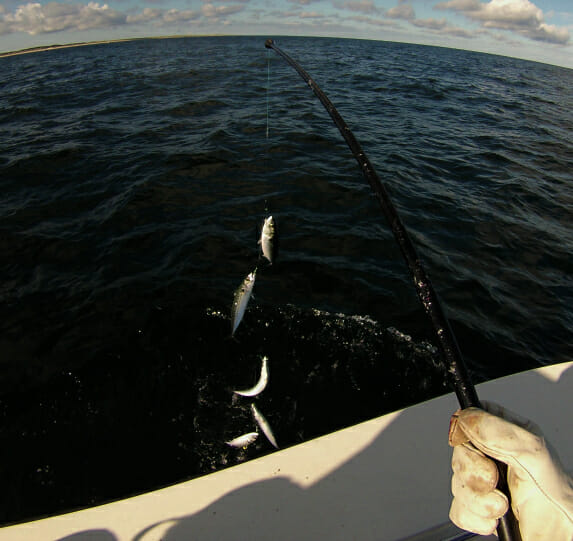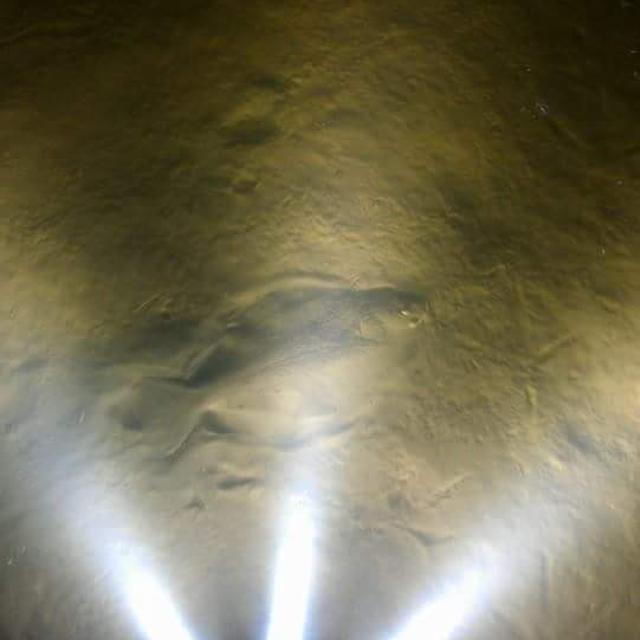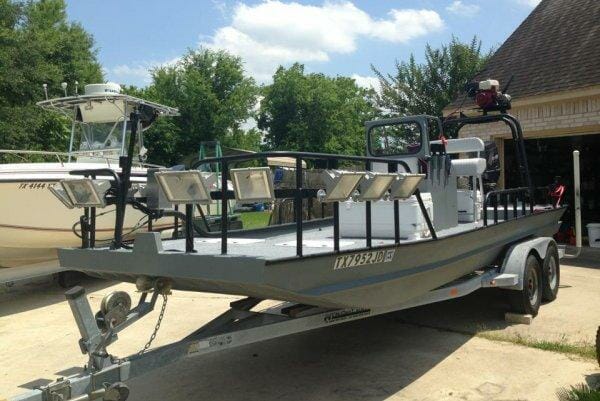If you are catching a lot of live bait like mackerel and threadfin herring then the best way to haul a tonne of them onboard quickly is using a sabiki rig. A good sabiki rod or two will make life a lot easier.
The biggest complaints you’ll often here about using a sabiki rig is the tangled mess they can become on board when not in use.
That and the fact that you have 6-10 small hooks just waiting to get snagged in something can end up driving you crazy, fast!
Enter the sabiki rod.
A sabiki rod is a purpose built rod blank that the line and rig run through the middle of the rod rather than through traditional eyes once pulled in. The aim here is to keep the rig and all it’s little hooks enclosed in the rod blank so that once on board they can’t cause any trouble.
There are usually only two types of sabiki bait sticks available ones with a line guide before the line feeder and ones without.
The sabiki poles that have an added line guide before the line is threaded into the rod blank are suitable for use with both baitcaster/conventional type reels and spinning reels.
If the rod blank does not have a line guide then it usually best not to use a spinning reel with it.
On a boat I always favor the conventional reel than a spinning reel as you will be essentially vertically jigging the sabiki rig and casting is not an issue.
Best Sabiki Rods
1. AHI USA Sabiki Stick Bait Rod
You have the option or either a 7 or an 8 feet model and to be honest the choice should be determined by how long your sabiki rig is going to be.
Choose the 7 foot model and an 8 foot length of jig then you’ll either have to contend with and extra hook hanging freely when all others are covered or just cut off the last one.
If you are in a kayak the 7 footer may be easier to handle.
It breaks down into 3 small pieces so is easy enough to transport and this also make it easier to thread the line through it when you first set it up.
Specifications:
- 8 foot in length
- Suitable for both spinning and baitcast/conventional reels
- Great build quality
- Available in both 7 or 8 feet options
- Canvas carry bag included
Buy on Amazon
2. EAT MY TACKLE Sabiki Rod
This is a 7 foot option from EAT MY TACKLE which makes it more suitable to kayaks or smaller fishing boats.
It is a two piece rod making transport and storage quite simple.
Unlike the AHI rod above it does not have a line guide before the opening for the line in the blank so it is suitable for baitcast/conventional reels only.
Not really suitable for casting your sabiki rig any meaningful distance unless you have a fairly heavy weight on the end of the rig.
Specifications:
- 2 piece, 7 foot rod
- Baitcast or conventional reels only
- Strong fiberglass construction
- Lifetime warranty
3. Promar Sabiki Stick
It breaks down easily into three sections and also comes with a storage bag. These rods are very well built and can take quite a bit of abuse.
Specifications:
- Three piece
- 7 or 8 foot models
- 1 line feeder guide
- Comes with a storage bag
Sabiki Rod and Reel Combo
Purchasing a sabiki rod and reel combo as an all in one deal is a great way to get serious value for your money.
You can also rely on the rod and reel being perfectly suited to each other.
The Eat My Tackle Combo below is the best of the bunch.
Eat My Tackle Sabiki Combo
The reel is a light-weight conventional reel that can hold up to 120 yards of 10 lb mono and is perfectly matched to the rod.
It is a right hand retrieve, has a star drag and a one way clutch.
Specifications:
- 8 foot rod
- Gear ratio 5.0:1
- Holds 120 yd of 10 lb mono
Sabiki Reels
Although you can use spinning reels with sabiki fishing rods my preferred setup when jigging from a boat is to use a small conventional reel.
The best time to use a spinning setup is when you are casting from a pier. Sabiki rigs can be quite light and casting them any kind of distance from a pier using a conventional reel can be a little difficult.
But on a boat hands the conventional reel the way to go.
You don’t need anything to fancy, a plain level wind with a line counter works great.
Always make sure to rinse your reels in fresh water after use, it will improve their lifespan significantly.
1. Penn Rival Level Wind
For such a small and light conventional reel the Rival is still built from some very high quality materials. Marine grade bronze alloy main gear and carbon fiber drag washers ensure a smooth operation.
The smaller model is best suited for bait fishing and can hold 475 yards oof 15 lb monofilament fishing line.
Specifications:
- HT-100 carbon fiber drag washers
- 2 stainless steel ball bearings
- Frame and sideplates from lightweight graphite
- Line capacity rings
2. Okuma Magda Pro Line Counter
Okuma line counter reels some of the most reliable available. They are use on large freshwater lakes and for trollig at sea for smaller sized sport fish.
The Magda Pro in the smaller sizes make a great little sabiki reel.
With the added bonus of a line-counter builtin you can always be sure of just how deep exactly your rig is.
Specifications:
- Carbon drag system
- Built in linecounter
- 2 stainless steel ball bearings
- Self lubricating gear system
- 1 year warranty
Sabiki Rod
Sabiki Rods are pretty are a great way to keep your Sabiki rig from becoming a tangles mess. A common complaint with using a conventional rod for a sabiki rig is that once you reel them in and attempt to store them the rig becomes a massive tangles mess.
Not only do the get tangled up on all the rod eyes and main line but usually some of the hooks will end up getting snagged on some thing on the deck of the boat.
For me it was always one of either two landing nets. Hooks just love to get caught in nets and they are a real pain to untangle especially when you could be doing something more fun like actually using your new bait ti catch some real fish.
A Sabiki rod is essentially a rod that is hollow in which the main line runs through as opposed to conventional rod guides and eyes.
The design of a sabiki fishing rod is that it is actually wider at the top. The tip of the rod has a large opening. The opening has smoothed sides that allow your rig to enter the tube without snagging. Once the rig is fully enlosed in the rod tube there is no chance of any kind of tangle happening.
You can usually pair a sabiki baitfish rod with a simple and in-expensive level wind or conventional reel.
Personally I use whatever old reels I have. If a reel has been retired from active duty on my main fishing setup them I’ll re-spool it with lighter line and then use it on my baitfish rods.
Most solid reels will last a long time when used as part of a sabiki rod and reel combo. Just remeber to rinse them out with fresh water after every trip whether you use them or not.









